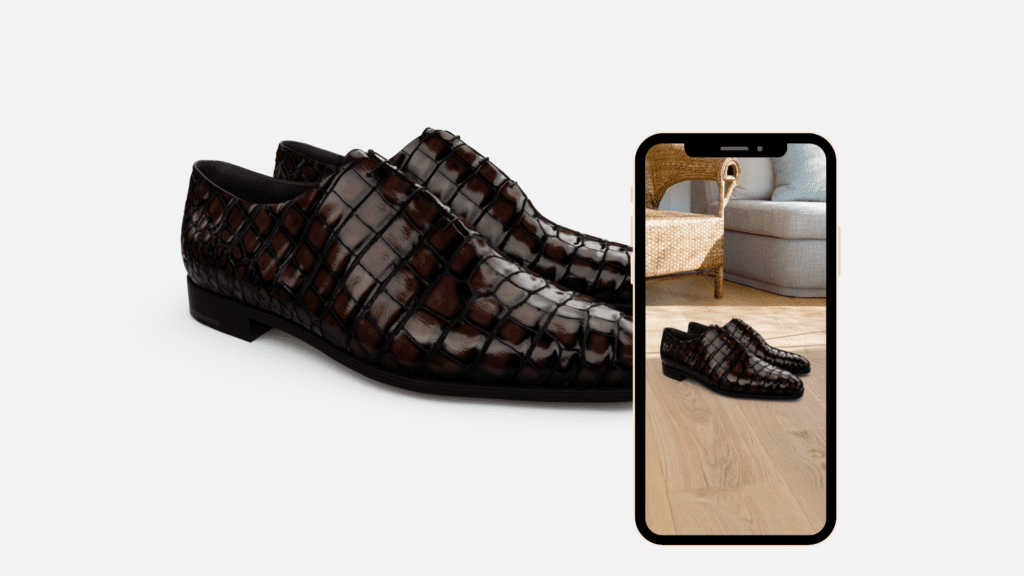Why use Augmented Reality for your brands?
From military, industrial, and medical uses of Augmented Reality, the one that most retains our attention is Augmented Reality for retail, and more specifically luxury fashion. In recent years, brands have been capturing the use of such technology to embrace all the aspects they could use to their advantage. Offering more tailored and reliable customer journeys, brands have seized the entire meaning of AR for luxury.
If it is still unclear to you why brands would want to use Augmented Reality in their businesses, then you have stumbled upon the right article. Reading this article, you will discover the benefits of integrating AR in your offers, for consumers and brands.
Augmented Reality: definition
AR “Interacts directly with and overlays onto the dynamic external reality […]; runs interactively in 3D and real time” _ McKinsey.
In other words, Augmented Reality is an extension of reality through digital features. Just as magnifying glasses augment the way we see the world, AR adds to the real world we know and cherish. AR is the superimposition of digital items or features into a real-life environment. You could say that it is a digital projection of something into the real world.
For example, if you wish to visualize a piece of furniture, you could do it with augmented reality. With a 3D render of your furniture, you could visualize the digital version of the item in your own environment. You could still see your couch, coffee table, and carpet but an additional digital item will be placed where you point your phone at in the first place.
Thus, moving and turning around the product as well as getting closer to it allows you to visualize its properties in the slightest detail.
3 benefits of using AR
Using Augmented Reality offers numerous advantages for both end consumers and retailers alike. As we delve deeper into the topic, we will explore the specific benefits that AR brings to both types of users, highlighting the way it revolutionized the retail and luxury industry.
A. 3 benefits of AR for consumers
On the one hand, the one who stares through the lens must enjoy the image they have and bring them superior value when doing so. As such, Augmented Reality benefits end consumers through different features. For example, implementing an AR tool for shopping enhances the customer experience in several ways.
1. A brand-new experience
First, Augmented Reality concentrates on the interaction of a user with a digital object displayed in the real world but still out of reach. The object is represented through 3D rendering which engages the user on another level. Consumers can visualize their product in their own environment from any angle. Moving around the object allows them to truly experience the feeling of possessing the object in their environment.
Moreover, with more engaging 3D visuals, the consumer experience becomes more entertaining and amusing, increasing customer curiosity and interest in the brand. This pushes the customer’s desire to discover more surrounding it.
2. Meeting lofty standards
Second, in the case of photorealistic 3D visuals, the visuals perfectly match the product in real life which allows a more realistic and trustworthy visualization process. The details are represented exactly as they are on the real product. The materials react to the environment exactly as they would in real life. Thus, the client’s expectations are met, which increases consumer satisfaction.
3. Practicality
Finally, another AR feature that benefits consumers is Virtual Try-On (VTO). VTO allows customers to virtually try on articles to save time. VTO contributes to enhancing the consumer experience through a simpler and more efficient way to try on items without queuing to the fitting rooms or returning articles that do not suit them.
B. 3 benefits of AR for luxury brands
On the other hand, brands offering AR solutions can also benefit from it.
1. Enhanced brand image
The increased consumer satisfaction due to mobile AR features leads to consumer trust and loyalty as an advantage for the brands that offer Augmented Reality experiences to their consumers. By doing so, brands assure themselves repeat customers with positive word-of-mouth to spread the good word about their image and brand experience. Indeed, Augmented Reality can increase conversion rates by 40%, according to Forbes’s saying.
Furthermore, leveraging Augmented Reality for luxury brands can drastically reduce their product returns.
2. Reduced product returns
In the luxury industry, 25% [1] of online purchases are returned to their issuing brands compared to 5 to 10% of in-store purchases [1]. The main cause of returns for articles is the non-conformity between the description of the product and the way it truly looks. To illustrate, 27% [2] of shoppers return goods because they were not “as they were described”. With 3D visuals meeting clients’ expectations, returns can be reduced by around 25% [3].
3. Competitive advantage with AR
Indeed, according to Shopify, 65% [4] of shoppers are more likely to make an order after interacting with AR. Thus, if a brand possesses an AR offer, it is more likely that the feature serves as an advantage compared to its competitors.
Furthermore, luxury brands can couple the feature with a higher price as a study has shown that 40% [5] of consumers are ready to pay a premium for a customizable offer in AR. Thus, benefitting from an increase in revenues as well without having to increase production.
Conclusion
Overall, Augmented Reality for luxury provides numerous advantages to luxury brands and their consumers.
Today, many brands have already tested and approved the integration of Augmented Reality in their offer. If you wish to learn more about fashion brands’ initiatives with AR, download our White Paper down below: Through the magnifying glass: understanding Augmented Reality for luxury brands.
Through the magnifying glass: understanding Augmented Reality for luxury brands
The AR market is prosperous and on the rise. But how can your brand grasp added value from Augmented Reality?
In our paper, you will discover :
- the history of AR,
- its benefits,
- how brands leverage its power today.


